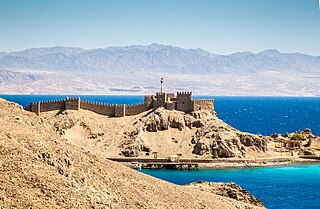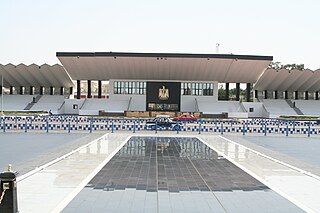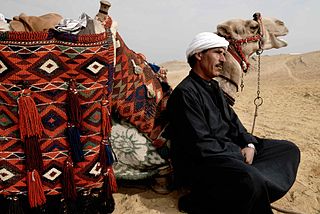
The Sinai Peninsula, or simply Sinai, is a peninsula in Egypt, and the only part of the country located in Asia. It is between the Mediterranean Sea to the north and the Red Sea to the south, and is a land bridge between Asia and Africa. Sinai has a land area of about 60,000 km2 (23,000 sq mi) and a population of approximately 600,000 people. Administratively, the vast majority of the area of the Sinai Peninsula is divided into two governorates: the South Sinai Governorate and the North Sinai Governorate. Three other governorates span the Suez Canal, crossing into African Egypt: Suez Governorate on the southern end of the Suez Canal, Ismailia Governorate in the center, and Port Said Governorate in the north.

Taba is an Egyptian town near the northern tip of the Gulf of Aqaba. Taba is the location of Egypt's busiest border crossing with neighboring Eilat, Israel. It is the northernmost resort of Egypt's Red Sea Riviera.

Sharm El Sheikh, alternatively rendered Sharm el-Sheikh, Sharm el Sheikh, or Sharm El-Sheikh, is an Egyptian city on the southern tip of the Sinai Peninsula, in South Sinai Governorate, on the coastal strip along the Red Sea. Its population is approximately 73,000 as of 2023. Sharm El Sheikh is the administrative hub of Egypt's South Sinai Governorate, which includes the smaller coastal towns of Dahab and Nuweiba as well as the mountainous interior, St. Catherine and Mount Sinai. The city and holiday resort is a significant centre for tourism in Egypt, while also attracting many international conferences and diplomatic meetings. Sharm El Sheikh is one of the Asian cities of Egypt.

South Sinai Governorate is the least populated governorate of Egypt. It is located in the east of the country, encompassing the southern half of the Sinai Peninsula. Saint Catherine's Monastery, an Eastern Orthodox Church monastery and UNESCO World Heritage Site of world renown, is located in the central part of the governorate.

Dahab is a small Egyptian town on the southeast coast of the Sinai Peninsula in Egypt, approximately 80 km (50 mi) northeast of Sharm el-Sheikh.
The April 2005 attacks were three related incidents that took place in the city of Cairo, Egypt, on 7 April and 30 April 2005. While the first killed three bystanders, the latter two incidents are generally considered to have been minor, in that they caused no loss of life other than those of the perpetrators and appear not to have been planned in advance. Neither sophisticated methods nor sophisticated materials were used in the incidents, and the Egyptian authorities have consistently described the attacks as "primitive".
The Ghazala Gardens hotel was a 176-room, four-star establishment in the Naama Bay area of the Egyptian beach resort of Sharm el-Sheikh, on the Sinai Peninsula. Its sister hotel, the Ghazala Beach, is across the street and is substantially larger. On July 23, 2005, at about 01:15 local time a terrorist drove a pickup truck laden with explosives through the glass façade and into the front lobby. Seconds later, the truck exploded, killing a number of people and razing the lobby. It is not known exactly how many died in the Ghazala Garden attack, but a total of about 90 were killed in the series of attacks that night. In the weeks after the blasts the remains of the hotel were demolished.

The 2004 Sinai bombings were three bomb attacks targeting tourist hotels in the Sinai Peninsula, Egypt, on 7 October 2004. The attacks left 34 people dead and 171 injured.

Ras Sedr is an Egyptian town located on the Gulf of Suez and the Red Sea coast. It is a part of the South Sinai Governorate, and consists of three areas: Wadi Sedr, Abu Sedr and Soerp. The region has been known since ancient biblical times. Ras Sudr was the last point of Sinai that was conquered by the Israelis on 8 June 1967 during the Six Day War. That was followed by the Ras Sedr massacre when Israelis killed Egyptian POW’s. In 1975 it was returned to Egyptian control.

The Dahab bombings of 24 April 2006 were three bomb attacks on the Egyptian resort city of Dahab, in the Sinai Peninsula. The resort town is popular with Western tourists and Egyptians alike during the holiday season.
The Sinai bus crash was a bus accident in the Sinai Peninsula in August 2006 which left twelve Israeli tourists dead. The tourists, who were Israeli Arabs, were riding a chartered bus as part of a convoy of eight buses carrying Arab tourists. The bus overturned and landed upside down between Nuweiba and Taba. The survivors claimed the driver intentionally crashed the bus and the incident was a terrorist attack.

Terrorism in Egypt in the 20th and 21st centuries has targeted the Egyptian government officials, Egyptian police and Egyptian army members, tourists, Sufi Mosques and the Christian minority. Many attacks have been linked to Islamic extremism, and terrorism increased in the 1990s when the Islamist movement al-Gama'a al-Islamiyya targeted high-level political leaders and killed hundreds – including civilians – in its pursuit of implementing traditional Sharia law in Egypt.

The Taba Border Crossing, also known in Israel as the Menachem Begin Crossing, is an international border crossing between Taba, in Egypt, and Eilat, in Israel. The Taba Border Crossing is the southernmost point in Israel.

The 2009 Khan el-Khalili bombing was a terrorist attack that took place at 6:30 p.m. local time on 22 February 2009 in Khan el-Khalili, a souq in eastern Cairo, Egypt, killing a 17-year-old French teenager and injuring 24 other people. It was the first of the February 2009 Cairo terrorist attacks.

The Abdullah Azzam Brigades, or al-Qaeda in Lebanon, is a Sunni Islamist militant group, and al-Qaeda's branch in Lebanon. The group, which began operating in 2009, was founded by Saudi Saleh Al-Qaraawi and has networks in various countries, mainly in Egypt, Iraq, Syria, Jordan, the Gaza Strip and Lebanon.

Rocket attacks on the neighboring cities of Eilat, in Israel, and Aqaba, in Jordan, have been a tactic used by militants from the Palestinian Islamist group Hamas and organizations linked with Al-Qaeda because of the relative ease of launching rocket attacks against these two cities from adjacent desert areas. Most of these attacks target Eilat, the last attack on Aqaba was in 2010.

The 2010 Sharm El Sheikh shark attacks were a series of attacks by sharks on swimmers off the Red Sea resort of Sharm El Sheikh, Egypt. On 1 December 2010, three Russians and one Ukrainian were seriously injured within minutes of each other, and, on 5 December 2010, a German woman was killed when she was attacked while wading and snorkeling in the shallows close to the shoreline. The attacks were described as "unprecedented" by shark experts.

The 2014 Taba bus bombing was a terrorist attack on a tourist coach in Taba, Egypt on 16 February 2014. The bus had been parked, waiting to cross into Israel at the Taba Border Crossing, when a lone suicide bomber entered the open bus and detonated his explosives. Four people – three South Koreans and the Egyptian bus driver were killed, and 17 others injured.

In July 2013, at the same time as mass protests began against the 3 July coup d'état which deposed Mohamed Morsi, and in parallel with the escalation of the already ongoing jihadist insurgency in the Sinai Peninsula, pro-Muslim Brotherhood militants started violent attacks against policemen and soldiers in central and western Egypt. In the following months, new Islamist armed groups were created to reinstate Islamist rule in Egypt, like Soldiers of Egypt and the Popular Resistance Movement. Since 2013, violence in mainland Egypt has escalated and developed into a low-level Islamist insurgency against the Egyptian government.

Terrorism and tourism in Egypt is when terrorist attacks are specifically aimed at Egypt's tourists. These attacks often end in fatalities and injuries and have an immediate and sometimes lasting effect on the industry. Attacks take many forms; blowing up an airplane carrying tourists, drive-by shootings of tourists, knife attacks on tourists and suicide bombings in a location where tourists are congregated. On the timeline of these events, the 1997 Luxor Massacre stands out - 62 tourists were ambushed and killed.















